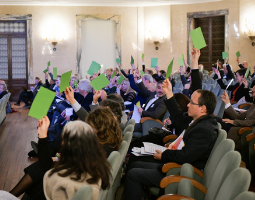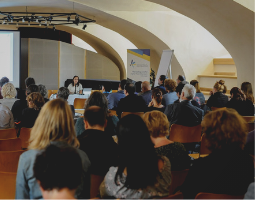A month ago, it was reported here in the AEC newsletter about the new AEC advocacy strategy that is currently being developed. Today, let’s take a closer look at another aspect of the advocacy activities which the AEC undertakes: joint advocacy activities with partner organisations which pursue the same or similar goals as the AEC.
Even if AEC particularly represents the interests of higher music education institutions, our voice joins our partners’ voices in order to preserve and support Europe’s arts, culture, and heritage and the values they promote.
AEC has taken part in numerous group initiatives in the past, that have either helped secure support for the sector or helped ensure that the cultural and creative sectors are included as priority sectors in the EU recovery plans.
Our association particularly benefits from joining forces with other networks and organisations in the cultural community. The strength of the music and cultural sectors also lies in these collaborations as culture is what brings us together.
This is not only because more voices saying the same thing are better heard, but also because whenever we put forward an idea, our conversation partners, the political decision-makers at the European Council and the European Parliament, first ask in whose name we speak. And if we then have to answer that we only speak for the higher music education sector in a matter that might affect the cultural and creative sector as a whole, we will hardly be listened to.
This is why it is important for AEC to be part of various umbrella organisations representing the interests of the entire music sector. These are the European Music Council (EMC) and International Music Council (IMC), and Culture Action Europe which is the most important overarching network in which all players in the cultural and arts sector come together at the European level. AEC is represented in all these three organisations by a member on the board, which ensures a good and constant flow of information in both directions. Here are a few selected, current examples of what it means to join forces when it comes to advocacy.
- EMC is one of the driving forces when it comes to bringing music-specific concerns to the European Commission, particularly those affecting the music sector in its whole range from the music business to higher education and from amateur musicians to professionals. With regard to European funding, the music sector has felt somewhat neglected compared to the audiovisual sector in recent years. Without a strong alliance, it would probably not have been able to convince the Commissioner to start a structured dialogue with the music sector, as is now scheduled.
- Culture Action Europe was one of the leading organisations to trigger and prepare a Policy Conversation with members of the European Parliament and the Commission’s vice-president Margaritis Schinas which will take place on 28 February. This event addresses overarching topics that are concerning the entire cultural and art sector. The timing is good, because, on the one hand, the 2024 elections of the European Parliament are casting their shadows ahead, on the other hand, the mid-term report on the Multi-Annual Financial Framework (MFF) 2021-2027 will be submitted soon. The result of this report will be crucial for the decision on what the focus of the following MFF will be.
- IMC is not the only, but possibly the most important partner linking AEC to the world of the globally active and relevant players in the field of cultural policy, in particular UNESCO. A regional consultation for the development of a UNESCO Framework on Culture and Arts Education took place online between 30 January and 2 February (the region was Europe). Mainly representatives of the national governments took the word on this occasion, but also stakeholder networks were invited, among them AEC. During the 3 days, a wide range of topics was addressed, e.g. the contribution of arts education to promoting critical thinking and intercultural competencies as well as the controversially discussed consequences of digitisation, the lack of qualified teachers and the issue of how arts education can be made more inclusive.
These few very recent examples alone show how important these partnerships among networks are for successful advocacy. As part of the upcoming AEC advocacy strategy, a separate chapter will be dedicated to these joint partnership actions.






